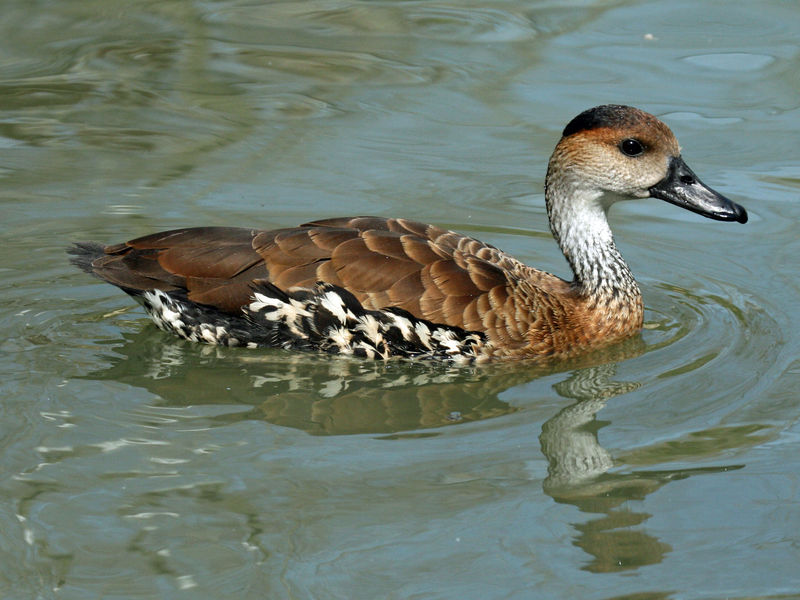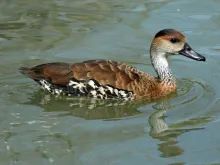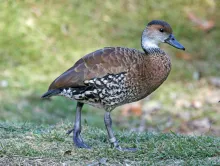
West Indian Whistling duck (Dendrocygna arborea)
Naamgeving
- Nederlandse naam:
- Cuba fluiteend
- Engelse naam:
- West Indian Whistling duck
- Duitse naam:
- Kubapfeifgans
- Franse naam:
- Dendrocygne
- Wetenschappelijke naam:
- Dendrocygna arborea
Taxonomische indeling
- Orde:
- Anseriformes
- Familie:
- Anatidae
- Onderfamilie:
- Dendrocygninae
- Geslacht:
- Dendrocygna
Beschrijving
- Uiterlijke kenmerken:
Male:
The male has a chestnut brown forehead, with a dark brown/black stripe from the crown down the back of the neck. Its face is pale ginger, fading to grey and white on the chin, throat and neck. The feathers on the back and tail are medium brown, as are the wings. The primary feathers of the upper wing have silvery buff patches on them. The duck’s sides and flanks are black with distinctive white mottling. They have a black Bill. Legs and feet are dark blue/black. In flight, the duck’s legs trail behind them and are longer than the tail.Female:
As male, though can be seen to be very slightly smaller When next to mate.Juvenile:
Duller and browner, less Rufous, then adults, with much-reduced black and white spotting and streaking on underparts, where black completely absent at first. Little or no Rufous on forehead and upper cheeks, and brown rather than black brown crown and nape, making head appear less marked.
- Gedrag:
Nest in loose groups. Loaf in small groups during the day. Form strong, probably permanent pair bonds.
Maten en Gewicht
- De man (woerd) van de West Indian Whistling duck heeft een lichaamslengte van ongeveer centimeters. De vrouw (pop) heeft een lichaamslengte van ongeveer centimeters.
- Het mannetje weegt ongeveer gram. Het vrouwtje weegt ongeveer gram.
Het gewicht is notoir variabel en kan alleen als indicatie worden gebruikt!
- Notitie:
Whistling-ducks generally do well, either in pens or in a park with access to extensive water area and good natural cover. They are gregarious outside the breeding season, and groups may bully smaller duck species, so should be kept in large areas, in which other birds have room to escape. Most need shelter in severe weather and a well-sheltered pen with frost-free night quarters for winter is suggested, or plenty of ground cover and/or straw to stand on, as they are susceptible to frostbite. They may be kept fully-flighted in aviaries, and have also been kept full-winged in open pens, tending not to wander. Perches should be provided at an appropriate height for pinioned or wing-clipped birds. Commercial pellets and grain are suitable for feeding.
Elevated nest boxes are appreciated by most species, although pinioned birds will use ground-level boxes; boxes may be placed over water or land. Eggs may be incubated by bantams and ducklings may be bantam-reared. Many species have been successfully parent-reared in captivity. Pairs kept isolated and fully flighted in a covered pen, with high-hung nest boxes "seldom fail to rear broods". Whistling-duck species may hybridise with one another and therefore should be kept in separate enclosures, and hybridisation has also occasionally been reported with Rosy-billed pochard (Netta peposaca).
These whistling-ducks are relatively numerous in collections and are bred fairly regularly. They require much space, preferably a large lake, and a slightly-heated shelter is required in winter. Some individuals are very aggressive, particularly in the breeding season - they have been reported to attack and even drown swans. They may be fed wheat and standard pellets, together with green food such as lettuce, duckweed and grass.
West-Indian whistling-ducks are fairly easy to breed; breeding results are best with a single pair. Eggs may be laid in the cover of ground vegetation, or in a ground-level nest box. Laying begins usually May or June. Ducklings require warmth, but are otherwise simple to hand-rear. They will carry food to the water to eat and may get their plumage soiled with food. If given swimming water, there is a risk of chilling unless they are immediately warmed under the duck or a heating lamp.
These ducks may hybridise with Fulvous whistling duck (Dendrocygna bicolor) and Plumed whistling duck (Dendrocygna eytoni).
- Breeding:
- Het vrouwtje West Indian Whistling duck legt doorgaans zo'n 6-12 white eieren het broeden duurt 28-30 dagen.
- Kunstmatig broeden:
De ideale relatieve luchtvochtigheid voor het uitbroeden van de meeste watervogeleieren is 55% voor grondbroeders en 40% bij holenbroeders. De temperatuur is meestal 37,4° C. Stel ventilatie in zoals aanbevolen door de fabrikant van de broedmachine. Eieren moeten minimaal 4 keer per dag automatisch of met de hand worden gedraaid. Naarmate de vrucht zich ontwikkelt, verliest het ei water en wordt de luchtzak groter. Bij normale ontwikkeling van een ei met een incubatietijd van 28-30 dagen neemt de luchtzak ongeveer een derde van het ei in beslag, dit bij drie dagen voor uitkomst. Reinheid is van vitaal belang en idealiter moet de luchtvochtigheid worden verhoogd tot 65% nadat de eerste tekenen van uitkomst zichtbaar worden.
- Ringdagen:
- Aanbevolen passende ringmaat voor de West Indian Whistling duck is 13 mm.De gesloten pootring kan alleen aangebracht worden bij een jonge whistling duck van ongeveer 12-14 dagen oud.
- It doesn't matter what leg that you band, but it's good to have a consistent system. Suggested: Left leg = Female, Right leg = Male


